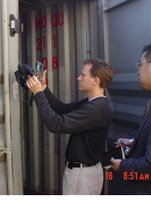Savi Moves RFID Beyond the Container
Radio Frequency Identification technology—better known as RFID—is helping retailers such as Wal-Mart Stores and Target track products coming into their warehouses, but more companies are employing the wireless technology well before that point as a means to keep its supply chain more transparent as well as deter counterfeits and improve security.
With the help of growing RFID networks, companies can track shipments from their origin at overseas factories through to their delivery point.
Technology providers such as GE, Weartech and Sunnyvale, Calif.–based Savi Technology Inc. are among those pioneering RFID networks across the supply chain.
Savi has emerged as the market leader with its SaviTrak system, which uses RFIDbased “e-Seals” and an open technology software system, which provides for real-time monitoring of shipments via the Internet.
The e-Seal technology is so sophisticated that shippers can determine the exact temperature inside a cargo container. They can also determine if a container has been tampered with at the point of origin or anywhere between the factory and distribution center. That is especially beneficial for high-end apparel shipments, which are often the subject of counterfeiting and theft, noted Mark Nelson, Savi’s director of corporate communications.
The Savi Network launched more than a year ago when the company struck a partnership with Hong Kong–- based Hutchison Port Holdings to build a network of RFID hubs at Hutchison-managed ports, which span 250 berths in more than 45 countries.
Savi actually started an RFID network going back 12 years, helping the military track supplies and weapons going in and out of Iraq and other international theaters. It launched the Savi Network in 2005 at a time when there were no standards for RFID.
Partnering with Hutchison allows Savi to use RFID in strategic positions in ports, such as on top of cranes, in dockways or on gates. Unlike passive RFID tags, which can only read tags from a short distance, Savi’s active tags can be scanned from 300 feet away. Savi developed supporting software to give companies and shippers access to the network via the Internet.
Customers include German retailer Metro Group, which will use SaviTrak to track goods from Asia into Europe. In Metro’s case, Savi will track goods from Hong Kong into Rotterdam, Netherlands, then Duisburg, Germany, and finally to a Metro distribution center in Unna, Germany. A number of other major U.S. athletic-apparel companies use the system but wished to remain anonymous.
Early adopters of the system have provided impressive case studies such as one company that said it saves $200 million per year by reducing production lead times, cutting inventories, streamlining information-technology needs and cutting labor costs.
Nelson said Savi is also negotiating with a major children’s apparel retailer to use the system.
“We’re bullish on RFID,” he said. “We think everything produced will eventually be tracked wirelessly within 10 years. We are encouraged by the response.”
Nelson said the shipping industry needs some more case studies such as those shared by Savi’s customers to grow the adoption rate.
Sense of security
Other success stories may come via security. Though the apparel industry is positioning itself to improve speed-to-market, security is also an issue, with rampant theft and counterfeiting taking place overseas. The federal government recently filed a lawsuit against China in an effort to thwart the rampant knock-offs of U.S.- branded goods.
“Supply-chain efficiency is the main objective with [Savi Network], but security issues are what keep many executives up at night,” quipped Nelson.
Some relief may come through the Port Security Act of 2006, which provides for regulatory incentives for shippers participating in the Customs-Trade Partnership Against Terrorism (CTPAT) program by adopting “best-of-breed” cargo security practices, including the deployment of container security devices in order to obtain faster clearance through checkpoints.
The exact nature of those incentives is still being worked out, said Nelson.
“Right now, the Department of Homeland Security is developing broad rules around the Port Security Act that further define container security devices and how they can be applied.
In the meantime, the International Standardization Organization is nearly finished with a new standard for e-Seals, which is based on Savi’s e- Seal products, explained Nelson. “So, a number of public-policy issues are converging right now that while they don’t mandate the use of RFIDbased e-Seals, they are encouraging their use.”
While many apparel companies currently view RFID as a cost of doing business with mass-market retailers, the technology should help them cut costs in other ways through shipping, manufacturing and retailing, noted Kevin M. Burke, president of the Arlington, Va.–based American Apparel & Footwear Association.
“There may be a day soon when RFID will be so prevalent that it will replace the current barcode technology. We will see,” he said.
























